| |
| ◎
The
Buddha Image│1│2│3│ |
|
◎The
Buddha Image of the World
The development of the
Buddha image follows the spread of Buddhism throughout the world. Artists
of different places and times have created images that are not only dignified
and graceful, but also serene in their beauty in accordance with the different
cultural backgrounds and local customs. Following are eleven images of
the Buddha from around the world, selected from the “Illustrated World
Buddhist Arts, Selected Edition” to demonstrate the many faces of the
Buddha image.
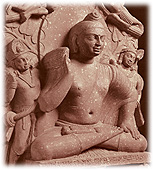 |
→Seated
Buddha, India
The Buddha image has a coiled topknot atop its head, full lips,
broad shoulders, thick chest, and clad in a thin garment, which
are characteristics of the Mathura images of the Kushan period.
|
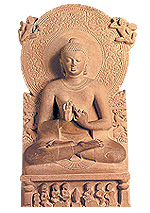 |
→The
Buddha's First Turning of the Dharma Wheel, India
The figure is clad in a completely smooth
garment that covers both shoulders to express the smoothness of
the skin, which emits a sense of nobility in its beauty. This is
a famous carving of the Gupta period.
|
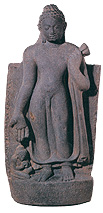 |
→Standing
Buddha, Nepal
The figure's head is covered by tight, distinct curls, resembling
conches and its body, in the “thrice bent” pose, is clad in a thin
robe, which resemble the style of the Mathura images of the Gupta
period.
|
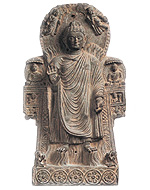 |
→The
Twin Miracles of the Buddha, Afghanistan
The so-called twin miracles of the Buddha
are the shooting flames and water from the Buddha's body as a display
of the Buddha's supernormal power in bringing into submission those
who have followed the wrong path. As depicted in the carving, the
flame shoots forth from the Buddha's shoulders.
|
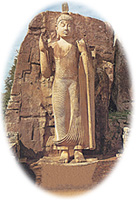 |
→The
Colossal Buddha of Aukana, Sri Lanka
Atop the figure's head is a flaming aureole; the folds of the robe
are spaced tightly in close intervals with strictly geometric ridges,
which are characteristics of Sri Lankan images. |
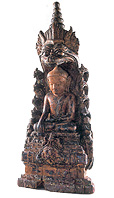
|
→The
Naga-King Mucalinda Sheltering the Buddha, Burma
The figure is depicted with a short neck,
hair that is not in curl, and a plain protuberance on top of the
head, which are characteristics of images from the late Pagan period. |
 |
→Phra
Achana, Thailand
The figure's protuberance is adorned by a flame-like ornament. Its
face is oval in shape and its eyebrows form a sweeping, clearly
defined curve from the bridge of its nose, which are characteristics
of Thai images.
|

|
→Seated
Buddha, Indonesia
The figure's head is covered by tight, distinct
curls resembling conches with a high protuberance; its eyes are
cast downward. Clearly, this image is influenced by the style of
the images from the Indian Gupta period. |
 |
→Seated
Sakyamuni Buddha, Grotto No. 20, Yungang Grottoes, China
The figure has a full and round face, a high nose, long eyebrows,
and a high protuberance on the top of the head. An outer garment
drapes over the left shoulder, exposing the right shoulder, and
the body is voluminous and majestic in appearance, which are the
styles of the Gandharan images.
|
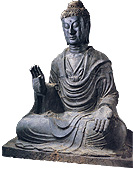 |
→Asuka
Daibutsu, Japan
The face and the body of the Buddha image
are elongated and flat; the folds of the garment are complicated
and symmetrical, which show a great stylistic influence from the
Northern Wei dynasty in China.
|
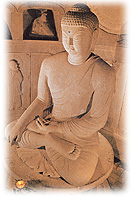 |
→Seated
Sakyamuni Buddha, Seokguram Grotto, Korea
The body of the Buddha image is round and robust, with a cranial
protuberance covered by tight, distinct curls, resembling conches.
With the right shoulder exposed, the figure wears a faint smile,
which exudes a quiet sense of serenity. It shows the stylistic elements
of the images made during the height of the Tang Dynasty in China.
|
|
|











